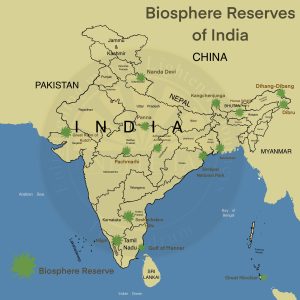Why in the news?
- The Cold Desert Biosphere Reserve (CDBR) in Himachal Pradesh, along with 25 other biosphere reserves across several countries, has been included in World Network of Biosphere Reserves (WNBR) by UNESCO.
UNESCO World Network of Biosphere Reserves (WNBR)
- Launch: The World Network of Biosphere Reserves (WNBR) is part of the UNESCO Man and the Biosphere (MAB) Programme, launched in 1971.
- Objective : Objective: To promote sustainable development by balancing conservation of biodiversity, economic development, and socio-cultural well-being.
- Functions:
- Conservation: Protect genetic resources, species, ecosystems, landscapes.
- Development: Foster sustainable economic & human development.
- Logistic Support: Provide sites for research, monitoring, education, and training.
- Zonation of a Biosphere Reserve:
- Core Area: Strictly protected for conservation of landscapes, ecosystems, species.
- Buffer Zone: Surrounds the core; limited activities like research, education, tourism.
- Transition Zone: Outermost; sustainable resource use, human settlements, traditional practices.

Cold Desert Biosphere Reserve (CDBR)
- Established: 2009 under India’s Biosphere Reserve Programme.
- Location: Himachal Pradesh, in the western Himalayas.
- Physical Features:
- Climate: Extreme cold, low rainfall (<12 cm annually), dry winds.
- Geography: Part of the high-altitude Trans-Himalayan region, characterized by cold arid climate.
- Topography: Rugged mountains, glaciers, alpine meadows, and cold deserts.
- Rivers: Chenab, Spiti, Sutlej and their tributaries.
- Flagship Species: Snow Leopard.
- Vegetation: Alpine & dry temperate vegetation
